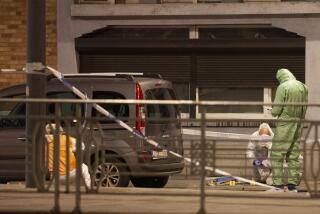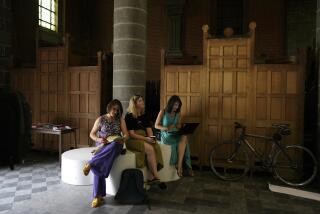Brussels’ Grand Place Puts All of Life on Stage
- Share via
BRUSSELS — Few memories of Europe are etched more vividly in a visitor’s mind than those of its magnificent plazas and piazzas: Venice’s Piazza San Marco, the Plaza Mayor of Madrid and Salamanca, Vienna’s Heldenplatz, the sweep and majesty of Paris’ Place de la Concorde.
Yet these and many other famed squares tend to be exquisite set pieces, reflecting in their beauty a certain uniformity of style and era.
Brussels’ stunning Grand Place seems more like a sparkling Christmas tree hung with a fanciful melange of medieval, Italo-Flemish, Renaissance, Baroque, flamboyant Gothic and other architectural styles characteristic of the ancient Guild Houses that line the square.
On first walking into the Grand Place, Jean Cocteau, the French author and playwright, proclaimed it “the richest theater on earth.” Some of the colorful performances against its magical backdrop are the daily flower stalls set up on the cobblestones of this medieval marketplace, perhaps a bird or flea market in one corner, other lively happenings of some sort going on year round.
Brussels has, for some reason, never really captured the imagination of many 20th-Century travelers in the same manner as other European capitals, being thought of mainly as a commercial crossroads (which it has been for a millennium) and the rather colorless administrative center for the emerging European Community. Nothing could stretch the truth more.
Visitors will enjoy walking from the Grand Place into the surrounding warren of narrow streets, with their astonishing array of quaint buildings and superb restaurants. Visit the Museum of Ancient Art, which brims with Flemmish-Belgian masters and the earthy works of Peter Breughel. Then there’s Mannekin Pis, the renowned little bronze boy who has been relieving his remarkable kidneys in public for all to see since 1619.
In many ways, Breughel’s down-to-earth paintings exemplify the pragmatic locals: taking everyday life with a grain of salt and an almost total lack of pretension, resigned to life’s vagaries yet determined to enjoy it to the fullest.
Life for Belgians hasn’t always been so easygoing. For 10 centuries the country has been a battleground for half the barbaric hordes, crowned heads and chancelleries of Europe, all bent on conquest of this peaceful and bucolic land. Napoleon finally met more than his match in the intrepid Wellington, a few minutes south of Brussels on the rolling farmlands of Waterloo, and the face of Europe was forever changed.
Brussels deserves at least two days for any serious visitor, and since Belgium is such a small country, the lovely towns of Brugge, Gent and the villages of the Ardennes Forest are little more than an hour’s train ride away.
With the dollar continuing its scary dive, this town--like most of Europe’s big cities--is sure to send more shock waves through your travel budget. And may we suggest late spring to late fall are best times for a visit, with the dead of winter being altogether inhospitable to man and beast.
Getting settled in: Not too long ago, Brussels was rather hotel-poor, particularly in the moderate-cost category, but things have been looking up of late. Hotel Arlequin, a short walk from the Grand Place, is a small hotel garni (breakfast only) that’s a bit difficult to find but worth the effort. You enter its white marble lobby from a little shopping gallery. Bedrooms are neat and contemporary, and there’s a bright breakfast room and bar, and lots of good restaurants nearby along Rue des Bouchers and Rue Dominicains.
Novotel, like all of these hotels, is also very central and convenient to shopping and sights. This one is a fairly recent addition, a stately building in 16th-Century Spanish style but modern within. Bedrooms have all the big-hotel amenities, full restaurant and bar. Novotel is also convenient to the central railway station.
Hotel Ibis, on the same square as Novotel, is a notch down in cost yet has most of the same comforts and conveniences. The Ibis chain isn’t noted for the warmth of its interior, being more a modern, utilitarian operation.
Regional food and drink: Belgians claim that their food is the equal of their French neighbor, a lofty height it certainly rises to often, but menus still have a Gallic flavor and there are few if any typically Belgian dishes popular outside the country.
They also share a love of waffles ( gaufres ) and mussels ( moules ) with the Dutch, a craze for the latter approaching unbridled passion. Although they are most succulent from September through December, you’ll find mussels almost anywhere year-round, usually in portions geared to trencherman appetites.
North Sea shrimp, fresh water crayfish and countless dishes of tender leeks are all staples, and the Belgian French fry rivals its namesake in glory.
Belgian beer, often made by religious orders, either doesn’t travel well or they keep it all for themselves, which may explain why it’s rarely found in America. But it’s sheer nectar in a glass for suds lovers.
Dining well: As in France, it’s really not necessary to seek out top restaurants to eat like royalty. Try the seafood specialties at modest l’Ogenblik (Galerie des Princes 1), a bi-level place with unadorned white-marble tables, sand on the floor and walls laden with mirrors in the French manner. You won’t find better shellfish, and they also do a fine saddle of lamb and wild duck.
Brasserie Scheltema (Rue des Dominicains 7) also bills itself as a seafood haven, with the likes of lobster from France’s Brittany, grilled Ostend sole, a cassoulet of crayfish. Scheltema’s decor is simple, with unfinished wooden floors and paper napkins on red-marble tables running the length of a long room that looks as if it’s right out of the 19th Century.
We’ve been visiting Aux Armes de Bruxelles (Rue des Bouchers 13) for three decades and each stop gets better, whether we choose the deli-like room or the more formal setting with a charming little conservatory. The gigantic menu runs the French-Belgian gamut, from Ardennes ham and entrecote with green pepper or bearnaise sauce to a half-dozen versions of fresh turbot. Friendly waiters here treat you like long-lost cousins.
Just across the street at Chez Leon, manic waiters hardly have time to nod as they scamper by with huge buckets and teeming plates of mussels. This multilevel and tumultuous place seems dedicated solely to dishing up the succulent shellfish in every conceivable way: Provencal, gratinee , Italian style, in a white-wine sauce or just boiled with garlic, shallots, parsley and a dash of white wine. Dedicated moule lovers usually go for the latter.
Going first-class: Given its Old World charm and superb location a block from the Grand Place, Hotel Amigo is the reigning grand dame of Brussels’ best lodgings. Belgian management has kept furnishings traditional yet understated, and everything about the lofty standards here will brighten your stay.
Brussels has a number of elegant first-class restaurants with chefs to match (Comme Chez Soi, Villa Lorraine, Bruneau), but for total immersion into exquisite decor, classic dishes and a dressed-to-the-nines mix of local and European movers and shakers, head for La Maison du Cygne, which overlooks the Grand Place from upstairs in the House of the Swan, formerly the Butchers’ Guild. You will be cosseted in velvet chairs and banquettes, served and fed like the king’s own and carry away warm memories of just how great Belgian food can be.
On your own: After an unhurried turn through the little streets around the Grand Place, many named for the medieval merchants who set up shop there , head for the Museum of Ancient Art and its truly monumental collection of masterworks from the 14th through the 18th centuries.
If Rubens “owns” Antwerp, Brussels and its museum belong to Peter Breughel the Elder and his pivotal effect on European art that previously concerned itself largely with religion and allegory. Feast on Breughel’s paintings of rustic and lusty peasants as they dance, wed, gorge and swill their way through everyday life in Flemish villages and countryside.
Major works of Rubens, Rembrandt, Frans Hals, Van Dyck, Memling and a pantheon of other masters of European art provide a rich banquet for the senses. The Museum of Modern Art is located on seven subterranean floors below the older works, all lighted naturally and filled with delights.
Lace fanciers will cherish a visit to the city’s Lace Museum, near the Grand Place, and “chocoholics” can take pleasure in sampling and buying what many consider the world’s best, although the renowned Godiva operation is now owned by a Japanese company. And what else is new?
GUIDEBOOK
Brussels
Getting there: American flies from Los Angeles to Brussels with stops in New York or Chicago. Service on Pan Am, TWA and several foreign carriers involves changes of aircraft. An advance-purchase round-trip fare should cost between $778 and $828.
Where to stay: Hotel Arlequin, Rue de la Fourche 17, $73 double B&B; Ibis, Grasmarkt 100, $112 double B&B; Novotel, Grasmarkt 120, $157 double; Amigo, Rue de l’Amigo 1, $190-$250 double B&B.;
For more information: Call the Belgian National Tourist Office at (212) 758-8130, or write (745 Fifth Ave., Suite 714, New York 10151) for brochures on Brussels, another on Belgium and its sights, plus a map of the country.
More to Read
Sign up for The Wild
We’ll help you find the best places to hike, bike and run, as well as the perfect silent spots for meditation and yoga.
You may occasionally receive promotional content from the Los Angeles Times.






